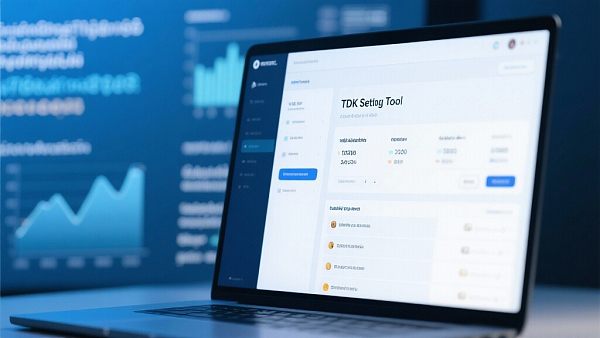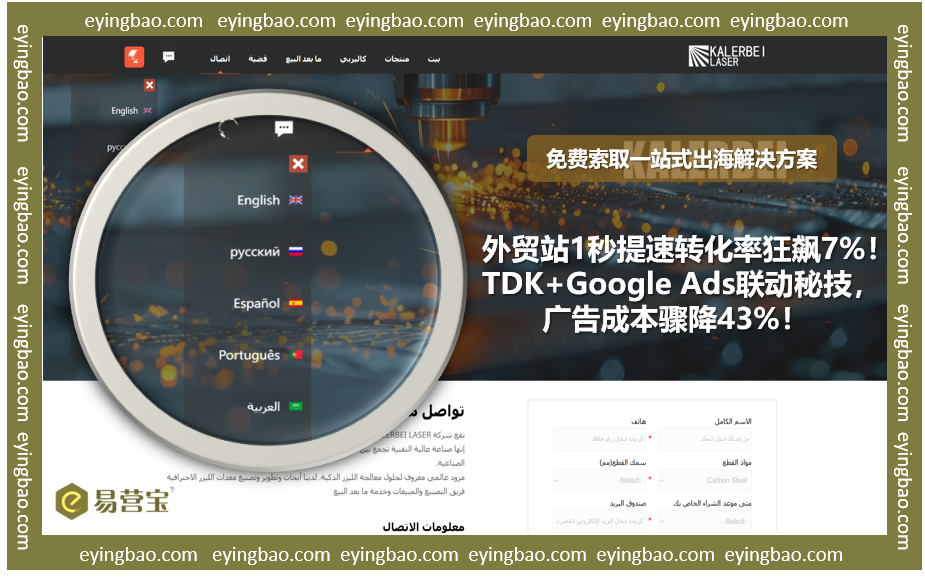EasyStore Cloud Intelligent Website Marketing System Platform!
I. The authoritative definition, strategic core, and market characteristics of TDK (Title, Description, Keywords) settings for websites using less commonly spoken languages
1. Authoritative Definitions and Professional Elements of TDK (Title, Description, Keywords) Setup for Minor Language Websites
**TDK settings for websites in less commonly spoken languages** refers to the process of optimizing a website's **Title, Description, and Keywords (although less important)** based on the target country's language, culture, and search intent. Key elements include: **localized keyword research (not literal translation), search intent matching, precise character count control, consistency between TDK and Hreflang tags, and TDK-driven click-through rate (CTR) design.**
2. Three irreplaceable strategic values of professional foreign language TDK setup
TDK (Title, Description, Keywords) are key for websites using less commonly spoken languages to benefit from search engine optimization.
- **Achieve precise traffic import and high CTR:** Optimized TDK accurately captures the search intent of local users, making the website more attractive on the search results page (SERP), significantly improving click-through rate (CTR) and bringing high-quality, precise traffic.
- **Enhancing the Authority of Localized EEAT:** Professional TDK language is authentic and uses precise terminology, which can convey the message that **"we are local professionals"** to search engines and users, thereby enhancing the website's authority in markets with less common languages.
- **Solving the Hreflang Weight Dispersion Issue:** Websites using less common languages often involve multiple language versions. The title, description, and keywords (TDK) must be consistent with the **target country/language** pointed to by the Hreflang tag to prevent search engine misinterpretation and ensure concentrated weight.
3. The Development History and Evolution of SEO TDK Settings for Less Commonly Taught Languages
Early stage (2000s): TDK settings relied on **machine translation or simple translation**, with extremely poor results; Keywords had high weight. Mid-stage (2010s): Attention began to shift towards **human translation and keyword stuffing**, but understanding search intent was insufficient. Modern stage (2020s to present): TDK has shifted towards **"user experience driven" and "search intent matching"**; Title and Description have become **key drivers of click-through rate (CTR)**, while Keywords have very low weight. Settings must be based on **localized content research and competitor analysis**.
II. Five Core Technical Principles for Setting Up TDK (Title, Description, Keywords) for Websites in Less Commonly Taught Languages: Localization, Intent, and Collaboration

Ensure that the underlying logic for the TDK (Task Knowledge Base) of less commonly taught languages is scientific and efficient:
1. Localized Keyword Research and Search Intent Matching Principles
Principle: Users of less commonly spoken languages have different search habits than English speakers, and directly translated keywords often result in low traffic. Practice: Utilize **localized keyword tools and native language experts** to analyze users' actual word usage under different search intents such as **transactional, informational, and navigational**. Integrate **the most high-potential localized keywords** into the title to precisely match search intent.
2. Title Tag Character Count and Truncation Optimization Principles
Principle: Titles that are too long will be truncated by search engines, affecting information display. Practice: Precisely control the title tag length (usually 50-60 characters) to meet the **pixel width limits** of different search engines (such as Google and Yandex). Ensure that the **most core keywords and brand name** are not truncated.
3. CTR-driven design principles of the Description tag
Principle: The description doesn't directly affect ranking, but it strongly influences click-through rate (CTR). Practice: The description should include the **core selling point, call to action (CTA), and a clear value promise**, while subtly incorporating core keywords to attract clicks. Keep the length within **150-160 characters**.
4. The principle of consistency between TDK and Hreflang tags
Principle: The technical structure of a multilingual website must be consistent. Practice: The **language and target region** used in TDK (Title, Description, Keywords) must be completely consistent with the **Hreflang tag attribute (e.g., lang="de-DE") set in the HTML head of the page** to avoid Google confusing the page's language and ensure correct page weight distribution.
5. The Strategic Application Principles of Keyword Tagging
Principle: Although keywords have extremely low weight, they can still have a slight impact on some less common language search engines or in specific competitive environments. Practice: Keywords tags **should not be used for keyword stuffing**. They can be used to **supplement some high-value long-tail keywords or synonyms**, but should not be used as the core optimization method. Focus your efforts on the Title and Description.
III. Four Core Technical Features and Applications of TDK Settings for Minor Language Websites
1. Technical Features: RTL/LTR-based character encoding and display optimization
Features: For **minor languages written from right to left (RTL) (such as Arabic and Hebrew),** the encoding and display of TDK must be adapted to RTL. Application: Ensure that the **layout and character order** of TDK on search results pages conform to local language conventions to avoid garbled characters or display errors.
2. Practical Application: TDK Strategy for Long Compound Words in German and Nordic Languages
Application: Languages like German contain a large number of **long compound words**. TDK (Title, Description, and Keywords) settings require mastering how to **split or combine these long words**, maintaining linguistic professionalism while ensuring they match the user's actual search phrases, and controlling title length.
3. Application Practice: TDK processing of accent marks in markets such as Spanish/French
Applications: In Spanish and French, **emphasis marks (such as á, é, ç)** affect spelling and searching. TDK settings must **use these special characters precisely**, while also considering users' tendency to omit accent marks during input and implementing **keyword variation coverage**.
4. Application Practice: Collaborative Optimization of TDK and Google Featured Snippets
Application: Optimize the Description tag to make its content **clearly structured and directly answer questions**, increasing the chances of being selected by Google as a **Featured Snippets**, thereby occupying an authoritative position at the top of the SERP and obtaining extremely high CTR.
IV. Comparative Analysis of TDK Settings for Less Commonly Used Languages vs. Traditional TDK Settings and Industry Scenarios

1. Comparative Analysis of TDK (Title, Description, and Skills) Setup for Less Commonly Used Languages vs. Traditional TDK Setup
2. Typical industry scenarios for setting up TDK (Title, Description, and Keywords) for less commonly spoken languages
Professional TDK (Title, Description, and Keywords) setup for less commonly spoken languages is key to expanding into the following niche markets:
- **B2B Machinery/Industrial Products:** In the German and Russian-speaking markets, there are extremely high requirements for the accuracy of TDK (Technical Terminology, Technical Knowledge, and Technical Information).
- **High-end customization/luxury goods:** In the Japanese and French markets, TDK must reflect the brand's emotional value and cultural sensitivity.
- **E-commerce in emerging markets:** Spanish (Latin America) and Portuguese (Brazil) require a rapid acquisition of search traffic through TDK (Title, Description, Keywords).
3. TDK's Standard Certification and Professional Specifications for Service Setup
Criteria for evaluating high-quality minority language TDK (Teaching, Speaking, and Knowledge) setup services:
- **Native Language Expert Team:** TDK writers must be native speakers of the target country and possess SEO knowledge.
- **Data-driven:** Tracking and iterating on the TDK (Target Data) performance based on data from Google Search Console, GA4, etc., in the target country.
- **Hreflang Report:** Provides a **consistency check report** for TDK and Hreflang tags to ensure technical compliance.
5. Optimize your TDK immediately to make your website an SEO leader in the less commonly spoken language market!
Is your website using incorrect TDK (Title, Description, Keywords) and losing valuable traffic? **The quality of your TDK directly determines your click-through rate!** Our **Minor Language TDK Optimization Service** provides you with **native-speaker expert writing, deep intent matching, and Hreflang collaborative optimization**. Sign up now for a **free "Minor Language TDK Competitiveness Diagnosis"** and get your personalized optimization plan!
Click to get a free TDK optimization solution.FAQ

Customer Reviews
 Is your multilingual independent website leaking orders? Unlock the underlying synergy logic between Google rankings and advertising costs.Every 1-second improvement in page loading speed increases B2B website conversions by 7%. Discover how SEO-optimized TDK slashes Google Ads costs by 43% through strategic alignment.
Is your multilingual independent website leaking orders? Unlock the underlying synergy logic between Google rankings and advertising costs.Every 1-second improvement in page loading speed increases B2B website conversions by 7%. Discover how SEO-optimized TDK slashes Google Ads costs by 43% through strategic alignment. International Gift-Giving Guide (China): The 'Bizarre' Gifts That Make Foreigners Cringe!Revealing the Gifts Foreigners Dislike in International Trade—Avoid Gift-Giving Pitfalls! Chinese tea and baijiu aren't universally loved, and food allergies require caution. Stay tuned for our foolproof gift guide—don't miss it!
International Gift-Giving Guide (China): The 'Bizarre' Gifts That Make Foreigners Cringe!Revealing the Gifts Foreigners Dislike in International Trade—Avoid Gift-Giving Pitfalls! Chinese tea and baijiu aren't universally loved, and food allergies require caution. Stay tuned for our foolproof gift guide—don't miss it!




